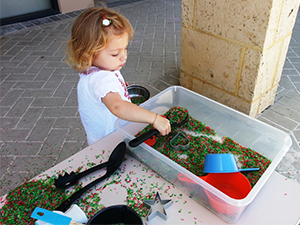Rice Play – Toddler
 Toddlers learn best through ‘hands-on’ experiences. Rice play is an easy activity to set-up that gets toddlers using all their senses. Rice can easily be coloured and can be used in a variety of playful, imaginative ways.
Toddlers learn best through ‘hands-on’ experiences. Rice play is an easy activity to set-up that gets toddlers using all their senses. Rice can easily be coloured and can be used in a variety of playful, imaginative ways.
Did you know?
Rice play is a great way for toddlers to playfully develop the fine-motor skills required for writing i.e. picking up tiny grains, passing handfuls from hand to hand, or scooping and pouring.
A shallow container or tray can be filled with rice. A variety of other tools or objects can be added to increase the fun! Try spoons, scoops, funnels, tubes or sand toys.
To colour the rice simply add a few drops of food colouring and mix through. You may want to use gloves. Or place the rice inside a zip lock bag for your toddler to hold and use their fingers to mix the colour. A spoonful of vinegar can help the rice and colour last longer. Spread out on a tray to dry. Then it is ready for play.
Add language
Rice play allows for fun early language exploration. Describe what you are doing as you play with the rice e.g. “pouring”, “scooping”, “finding”. Keep your comments short and then wait for your toddler to say or do something next.
Try hiding toys or other objects in the rice. Your toddler will naturally name items as they find them, “I got duck!” You can expand their language, “You found the yellow duck!” The hiding game provides the repetition needed for language development in a natural, playful way.
Other development
Pouring rice into containers of different sizes and shapes helps your toddler to start learning maths concepts of volume and comparing relationships e.g. more, less, bigger, smaller. Experimenting with scoops, funnels and sand-wheels develops early science skills.
Variations
Tubs of rice can easily be turned into ‘small worlds’. Add elements of pretend play like little people or toy animals e.g. dinosaurs, insects, or nature items.
Activities listed under “toddler” are suitable for children aged 1-3 years. Toddlers enjoy activities that include exploring their environment and finding out how things work.

